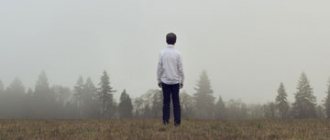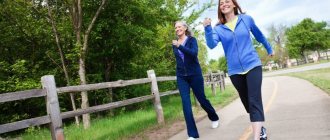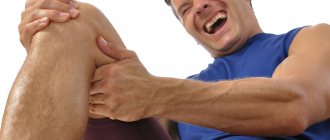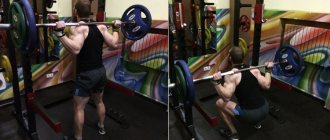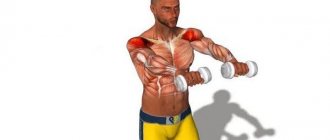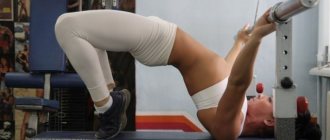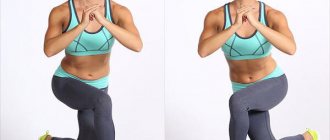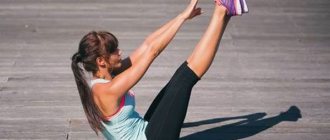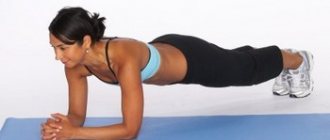Attention!
- If you have any damage or injury to your back, then lifting your legs is not advisable.
- It is better to place a pillow or cushion under your lower back to make your body position comfortable.
- Stretch your legs up along the wall, and stretch your arms along your body, they should be completely relaxed.
- It is enough to remain in this position for 15–20 minutes without doing anything else. Try to feel balance, feel calm, and a little later a rush of blood to your chest and head.
- Remember that clothing should be as comfortable and loose as possible; do not tighten the elastic bands around the waist or ankle.
PS How often do you feel heaviness and pain in your legs and lower back? How do you deal with this?
Source
VKontakte
Why is it so beneficial to lift your legs up the wall? 5 miracles from inverted pose
This golden rule is worth taking as a habit. In the evening, at the end of a grueling day, you need to lie down against the wall, raise your legs up and spend 10 to 15 minutes in this position. No additional equipment, just your legs and the wall. It is advisable to do this every day.
Just below there will be a video showing how to correctly take the bent candle pose . The exercise is very easy, accessible to everyone, no matter how old you are! I’ve been doing this for a couple of months now; I’ll tell you a little about the result this simple technique gives.
I have a tendency to swell my legs and my legs get tired quickly. Finding comfortable shoes is quite difficult due to the enlarged bones on the feet. I spend the whole day at work at the computer and in the evening I feel absolutely exhausted: if I don’t have the opportunity to work out or take a walk after work, my body feels like it’s alien due to prolonged sitting, I feel heaviness in my head and terrible lethargy.
When I learned about this exercise, of course, curiosity arose: how is it possible, you don’t need to do anything, you just lie against the wall and enjoy a therapeutic procedure for the whole body? Can't be. It turns out that this basic yoga pose can actually do magic.
Once you spend at least 5 minutes in this position, it’s as if you are reborn. Fatigue goes away, the body comes to life and invigorates, the head becomes clear. Thanks to this static exercise, you can still do a lot of things in the evening, your body becomes toned, and your legs feel light. I'm delighted with the effect!
Why is it so beneficial to lift your legs up the wall? During the day, our body is constantly in an upright position; the most harmful thing is to sit. Thanks to this accessible pose, the body will take a position opposite to its usual one.
The benefits of this simple, effortless inverted pose are great: the body quickly recovers, rests, tension is relieved from the spine, “heaviness in the legs” goes away, blood flow improves, you kind of train while you’re lying down, because the heart needs to work harder to pump blood up. legs
Prevention of varicose veins
See how to do this easy exercise correctly. Also, a nice girl will show you how you can slightly stretch your leg muscles while standing against a wall. Very useful, extremely simple!
https://youtu.be/sJsdf7zdts8
This pose with a calm soul can be called the most powerful prevention of varicose veins . During its implementation, venous outflow improves, swelling of the legs disappears, and the feeling of fatigue goes away. In addition, it alleviates the suffering of those who already know what a misfortune it is to have diseased veins.
HOW TO CORRECTLY DO THE BENT CANDLE POSE
- In yoga, this simple asana is called Viparita Karani. It is believed that when a person stands on his feet, he ages, but in an inverted position, all the processes of the body go backwards, and he becomes younger. The maximum benefit will be if you are in this pose in silence .
- Lie on your back with your hips about 30cm away from the wall. Bend your knees and place your feet on the wall. Make sure your hips are at right angles to the wall.
- Straighten your legs, lean their entire surface against the wall, keep your knees straight, relax your legs. Who would have thought that preventing varicose veins on the legs is so simple.
- Place a pillow under your head, it should be very comfortable. Close your eyes and breathe deeply. Place one palm on your stomach, the other on your heart.
- Become aware of your breathing, inhale for 2 counts, exhale for 4. Try to stop the internal dialogue, calm your thoughts, listen only to your breathing. This point is especially important for those who often experience stress at work, feel anxiety, or have insomnia. Calm, conscious breathing in an inverted pose will heal the nervous system and give a sense of balance.
If it’s difficult to breathe calmly and you’re distracted by extraneous thoughts, use my method. When you feel yourself starting to get distracted, roll your eyes, I prefer clockwise. This is easy to do with your eyes closed. This movement of the eyeballs helps restore concentration and guides you into a conscious state in which it is easier to control your breathing and what you are doing.
Rolling your eyes is also a good way to help you get organized in everyday life, cope with irritation, anger, impatience and stress; it has an immediate sobering effect.
- Stay in this asana for 10–15 minutes. Gently push your feet off the wall, lie down a little, turn on your right side and get up from the floor.
This pose improves memory because the blood supply to the brain increases when performed. The thyroid gland and other endocrine glands are also stimulated because they are washed with fresh blood . As I already said, this is the best prevention of varicose veins . With regular practice of this pose, aging slows down, wrinkles are smoothed out, and the appearance of the skin improves. The digestive process also noticeably improves!
The bent candle pose is really very nice to do. Even thinking about this process is pleasant, let alone doing it: the body completely relaxes and rests, the sensations are indescribably wonderful, complete relaxation. I'm sure you'll want to write a thank you comment if you try the exercise at least once! I wish you good health and serene lightness in your soul.
Source
How to develop abdominal strength, pump up your six-pack and increase endurance
It should be understood that it is impossible to pump up both at once. To achieve each goal, the tactics will be different.
Strength and volume
This exercise, in itself, when performed solo, is not very suitable for creating sculpted abs. To achieve pronounced results, it is necessary to combine it with other exercises for the abdominal muscles. It can be:
- double twists;
- etc.
Note that when performing abdominal exercises, in particular, lying leg raises, volume and strength can be increased by following the following rules:
- Number of approaches 3–4.
- Reps in each approach are 10–12.
- We use maximum weights (those when you can do 10–12 repetitions with the correct technique, no more).
- Adding loads. Do you feel like you can do more without your technique suffering? Let's increase it. Gradually, there is no need to rush!
Endurance
Everything is much simpler here. We do the maximum possible number of repetitions in a prone position in an accelerated version. Two approaches are quite enough to expand the limits of abdominal endurance. We work through the burning sensation in the muscles.
Exercise “Chair” against the wall: what muscles work, benefits
Some people believe that it is impossible to pump up a beautiful butt and thighs in a month without making Herculean efforts. If we talk about working people, this is completely impossible, due to the lack of free time and energy. In fact, this is quite possible if you combine dynamic exercises with static ones. Training can take no more than ten to fifteen minutes a day, and you can exercise in absolutely any place, even in a subway car, no matter how strange it may sound.
Many girls are afraid of strength training, so as not to build muscles like famous bodybuilders. They do not want to have relief that would be the envy of the most outstanding bodybuilders in the world and they can be understood. With the help of isometric exercises, including the “Chair” against the wall, you can make your body beautiful, with graceful curves, strong, resilient, while remaining tender and attractive. The famous strongman Alexander Zass, who bore the nickname Iron Samson, believed that thin but wiry, thin but hardy people are often much stronger than voluminous handsome men with “bulging” muscles.”
Physiology of the process: which muscles tense
When understanding why you need the wall chair exercise, you first need to understand exactly how to perform it correctly, as well as which muscles will be under isometric load. In fact, many muscle groups are involved in the work, which are pumped efficiently in just a few minutes of effort.
- Calf muscle.
- Almost all abdominal muscles.
- Quadriceps muscle (quadriceps). It is located on the front wall of the thigh, giving it a beautiful, rounded shape.
- The muscles of the lower as well as the upper back.
- Arm muscles.
After studying the exercise, you will fully feel how, with complete immobility (staticity), muscles can become extremely tense.
The benefits of the “Chair” exercise against the wall
Despite the fact that this exercise is primarily aimed at pumping the muscles in the buttocks, thighs and legs, a positive effect can be seen for the entire body as a whole.
- Normalization of blood pressure.
- Return to normal position of organs that were omitted (“floating” kidney).
- Ability to control breathing.
- Increased concentration.
- The buttocks and thighs are tightened and a beautiful shape is formed.
- Elimination of the so-called femoral “lugs”.
- Prevention of intervertebral hernias.
- Activation of blood circulation, which has a beneficial effect on providing tissues and organs with oxygen and nutrients.
- Development of the vestibular apparatus, development of self-control and sense of balance, the ability to maintain balance.
As an additional bonus, many cite the elimination of symptoms of minor stages of flat feet. Also a plus will be an obvious positive effect even with quite strong changes in the feet, provided that it is performed barefoot. However, many exercises are contraindicated for such pathology. A “chair” is not only acceptable, but even recommended.
Various performance techniques
Let's look at three options for lying leg raises, designed for people with different levels of physical fitness:
- People with weak abdominals who want to strengthen them.
- Physically trained people who want to make their abs stronger and more prominent.
- Athletes who require increased exercise.
Alternating Leg Raises for Beginners
Also, this version of the exercise is indicated for osteochondrosis or recovery after abdominal surgery.
- Starting position – lying on your back, lower back pressed to the floor. The arms are extended along the body or clasped behind the head.
- Beginners can raise their heads. Feet together. Raise one leg to an angle of 45–60 degrees, hold it for 1–2 seconds and lower it to the starting position.
- When the heel of the first leg touches the floor, you can lift the second leg.
- Repeat the same for the second leg.
Watch your breathing. Exhale at maximum load. That is, we raise our legs - exhale, lower them - inhale.
To recover after surgery, it is recommended to further bend the leg at the knee so that there is no discomfort at the incision site. Gradually straighten your leg until it straightens. Attention! After the operation, you must wait the minimum time specified by the doctor, after which you can do any physical activity!
During pregnancy, it is better to cancel this exercise. Women should put less stress on their abs than men. Overdeveloped muscles can make childbirth difficult.
Simultaneous leg lift without weights
This exercise option is suitable for healthy people with an average level of physical fitness.
- Starting position: as in the previous case. That is, lying on your back, on the floor. Raising your head is not recommended, as this makes the exercise easier. Feet together.
- We begin raising both legs to an angle of 45–60 degrees, pause for 1–2 seconds while raised and lower them back.
There are two variations of this exercise technique:
- Lowering your heels to the floor. This is easier to do, because when you touch the floor, your abs rest.
- Without lowering your heels onto a horizontal surface, leaving 1-2 cm to it. This is the most effective version of the exercise, which keeps your abs tense all the time.
It is recommended to perform 2-3 sets, starting with 10-12 repetitions. For yourself, you can reach 30 repetitions in each approach. You should start with the first option, when your feet fall to the floor. After 1–2 weeks, you can move on to the second option, when the heels do not touch the floor.
If desired, the legs can be held in the raised position for more than two seconds (depending on how you feel).
Lying leg raises with weights
If your abdominal muscles are well developed and you need to increase the load, this option is perfect.
The technique is the same as in the previous exercise. The nuance is this: a weighting agent is attached to each leg (standard on the mounts). Alternatively, you can hold a dumbbell with your feet. The weight of the dumbbell is selected individually.
Raise your legs to an angle of more than 60 degrees or less than 45. The meaning of the exercise is lost. When the legs are raised higher, the muscles relax. Below – the muscles do not reach peak tension.
How many times a week should you exercise
As an exercise, 1-2 sets of 10 repetitions can be done daily in the morning. Without weights, start by raising your legs one at a time. Depending on how you feel, switch to simultaneous lifting. Do not use weights.
To develop strength and abs, 2 times a week is enough. Remember, this is just one of several exercises, so you need to do other exercises to achieve this goal.
To develop endurance, you can train every day. Moreover, do the maximum number of repetitions 2 times a week. On other days - 2-3 sets of 30 times. For beginners, just 2-3 times a week is enough. Believe me, the effect will be noticeable.
